-
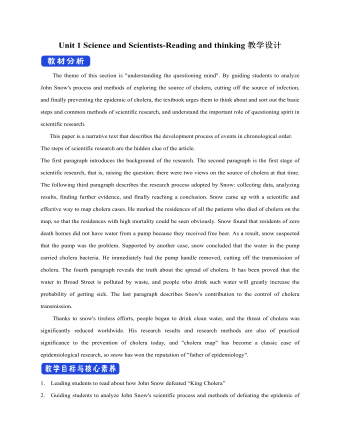
新人教版高中英语选修2Unit 1 Science and Scientists-Reading and thinking教学设计
Step 5: After learning the text, discuss with your peers about the following questions:1.John Snow believed Idea 2 was right. How did he finally prove it?2. Do you think John Snow would have solved this problem without the map?3. Cholera is a 19th century disease. What disease do you think is similar to cholera today?SARS and Covid-19 because they are both deadly and fatally infectious, have an unknown cause and need serious public health care to solve them urgently.keys:1. John Snow finally proved his idea because he found an outbreak that was clearly related to cholera, collected information and was able to tie cases outside the area to the polluted water.2. No. The map helped John Snow organize his ideas. He was able to identify those households that had had many deaths and check their water-drinking habits. He identified those houses that had had no deaths and surveyed their drinking habits. The evidence clearly pointed to the polluted water being the cause.3. SARS and Covid-19 because they are both deadly and fatally infectious, have an unknown cause and need serious public health care to solve them urgently.Step 6: Consolidate what you have learned by filling in the blanks:John Snow was a well-known _1___ in London in the _2__ century. He wanted to find the _3_____ of cholera in order to help people ___4_____ it. In 1854 when a cholera __5__ London, he began to gather information. He ___6__ on a map ___7___ all the dead people had lived and he found that many people who had ___8____ (drink) the dirty water from the __9____ died. So he decided that the polluted water ___10____ cholera. He suggested that the ___11__ of all water supplies should be _12______ and new methods of dealing with ____13___ water be found. Finally, “King Cholera” was __14_____.Keys: 1. doctor 2. 19th 3.cause 4.infected with 5.hit 6.marked 7.where 8.drunk 9.pump 10.carried 11.source 12.examined 13.polluted 14.defeatedHomework: Retell the text after class and preview its language points
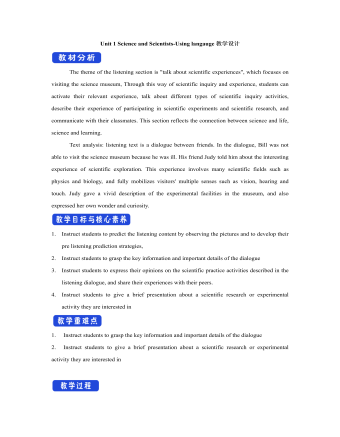
新人教版高中英语选修2Unit 1 Science and Scientists-Using langauge教学设计
This happens because the dish soap molecules have a strong negative charge, and the milk molecules have a strong positive charge. Like magnets, these molecules are attracted to each other, and so they appear to move around on the plate, taking the food coloring with them, making it look like the colors are quickly moving to escape from the soap.Listening text:? Judy: Oh, I'm so sorry that you were ill and couldn't come with us on our field trip. How are you feeling now? Better?? Bill: Much better, thanks. But how was it?? Judy: Wonderful! I especially liked an area of the museum called Light Games.it was really cool. They had a hall of mirrors where I could see myself reflected thousands of times!? Bill: A hall of mirrors can be a lot of fun. What else did they have?? Judy: Well, they had an experiment where we looked at a blue screen for a while, and then suddenly we could see tiny bright lights moving around on it. You'll never guess what those bright lights were!? Bill: Come on, tell me!? Judy: They were our own blood cells. For some reason, our eyes play tricks on us when we look at a blue screen, and we can see our own blood cells moving around like little lights! But there was another thing I liked better. I stood in front of a white light, and it cast different shadows of me in every color of the rainbow!? Bill: Oh, I wish I had been there. Tell me more!? Judy: Well, they had another area for sound. They had a giant piano keyboard that you could use your feet to play. But then, instead of playing the sounds of a piano, it played the voices of classical singers! Then they had a giant dish, and when you spoke into it, it reflected the sound back and made it louder. You could use it to speak in a whisper to someone 17 meters away.? Bill: It all sounds so cool. I wish I could have gone with you? Judy: I know, but we can go together this weekend. I'd love to go there again!? Bill: That sounds like a great idea!
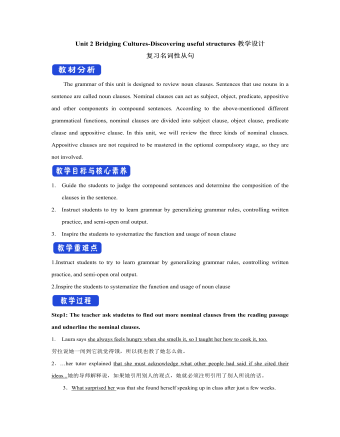
新人教版高中英语选修2Unit 2 Bridging Cultures-Discovering useful structures教学设计
The grammar of this unit is designed to review noun clauses. Sentences that use nouns in a sentence are called noun clauses. Nominal clauses can act as subject, object, predicate, appositive and other components in compound sentences. According to the above-mentioned different grammatical functions, nominal clauses are divided into subject clause, object clause, predicate clause and appositive clause. In this unit, we will review the three kinds of nominal clauses. Appositive clauses are not required to be mastered in the optional compulsory stage, so they are not involved.1. Guide the students to judge the compound sentences and determine the composition of the clauses in the sentence.2. Instruct students to try to learn grammar by generalizing grammar rules, controlling written practice, and semi-open oral output.3. Inspire the students to systematize the function and usage of noun clause1.Instruct students to try to learn grammar by generalizing grammar rules, controlling written practice, and semi-open oral output.2.Inspire the students to systematize the function and usage of noun clauseStep1: The teacher ask studetns to find out more nominal clauses from the reading passage and udnerline the nominal clauses.
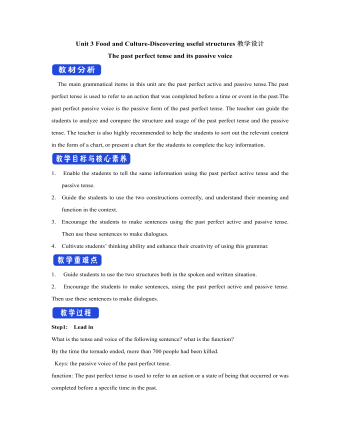
新人教版高中英语选修2Unit 3 Food and Culture-Discovering useful structures教学设计
The newspaper reported more than 100 people had been killed in the thunderstorm.报纸报道说有一百多人在暴风雨中丧生。(2)before、when、by the time、until、after、once等引导的时间状语从句的谓语是一般过去时,以及by、before后面接过去的时间时,主句动作发生在从句的动作或过去的时间之前且表示被动时,要用过去完成时的被动语态。By the time my brother was 10, he had been sent to Italy.我弟弟10岁前就已经被送到意大利了。Tons of rice had been produced by the end of last month. 到上月底已生产了好几吨大米。(3) It was the first/second/last ... time that ...句中that引导的定语从句中,主语与谓语构成被动关系时,要用过去完成时的被动语态。It was the first time that I had seen the night fact to face in one and a half years. 这是我一年半以来第一次亲眼目睹夜晚的景色。(4)在虚拟语气中,条件句表示与过去事实相反,且主语与谓语构成被动关系时,要用过去完成时的被动语态。If I had been instructed by him earlier, I would have finished the task.如果我早一点得到他的指示,我早就完成这项任务了。If I had hurried, I wouldn't have missed the train.如果我快点的话,我就不会误了火车。If you had been at the party, you would have met him. 如果你去了晚会,你就会见到他的。

新人教版高中英语选修2Unit 3 Food and Culture-Reading and thinking教学设计
The discourse explores the link between food and culture from a foreign’s perspective and it records some authentic Chinese food and illustrates the cultural meaning, gerography features and historic tradition that the food reflects. It is aimed to lead students to understand and think about the connection between food and culture. While teaching, the teacher should instruct students to find out the writing order and the writer’s experieces and feelings towards Chinese food and culture.1.Guide the students to read the text, sort out the information and dig out the topic.2.Understand the cultural connotation, regional characteristics and historical tradition of Chinese cuisine3.Understand and explore the relationship between food and people's personality4.Guide the students to use the cohesive words in the text5.Lead students to accurately grasp the real meaning of the information and improve the overall understanding ability by understanding the implied meaning behind the text.1. Enable the Ss to understand the structure and the writing style of the passage well.2. Lead the Ss to understand and think further about the connection between food and geography and local character traits.Step1: Prediction before reading. Before you read, look at the title, and the picture. What do you think this article is about?keys:It is about various culture and cuisine about a place or some countries.
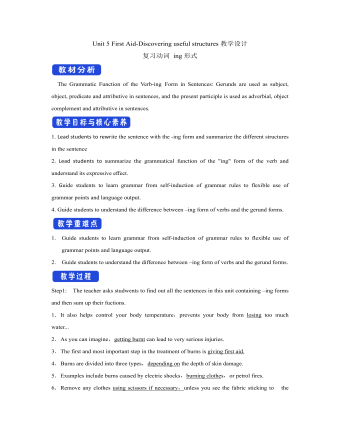
新人教版高中英语选修2Unit 5 First Aid-Discovering useful structures教学设计
You have no excuse for not going.你没有理由不去。He was punished for not having finished his homework.他因未完成作业而受到惩罚。2.动词ing形式复合结构由物主代词或人称代词宾格、名词所有格或普通格加动词ing,即“sb./sb.'s+doing”构成。动词ing形式的复合结构实际上是给动词ing形式加了一个逻辑主语。动词ing形式的复合结构有四种形式:①形容词性物主代词+动词ing②名词所有格+动词ing③代词宾格+动词ing④名词+动词ingHer coming to help encouraged all of us.她来帮忙鼓舞了我们所有人。The baby was made awake by the door suddenly shutting.这个婴儿被突然的关门声吵醒了。Can you imagine him/Jack cooking at home?你能想象他/杰克在家做饭的样子吗?无生命名词无论是作主语还是作宾语都不能用第②种形式。Tom's winning first prize last year impressed me a lot.汤姆去年得了一等奖使我印象深刻。Do you mind my/me/Jack's/Jack leaving now?你介意我/杰克现在离开吗?Excuse me for my not coming on time.很抱歉我没能按时来。His father's being ill made him worried.他父亲病了,他很担心。We are looking forward to the singer's/the singer to give us a concert.我们盼望着这位歌手来给我们举办一场演唱会。
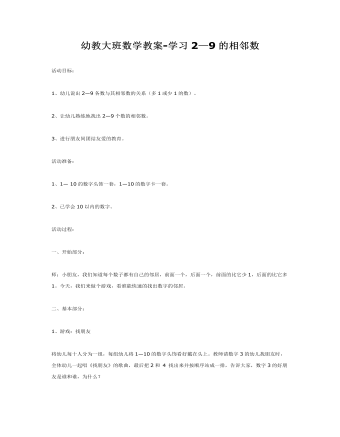
幼教大班数学教案-学习2—9的相邻数
2、让幼儿熟练地找出2—9个数的相邻数。3、进行朋友间团结友爱的教育。活动准备:1、1— 10的数字头饰一套,1—10的数字卡一套。2、已学会10以内的数字。活动过程:一、开始部分:师:小朋友,我们知道每个数子都有自己的邻居,前面一个,后面一个,前面的比它少1,后面的比它多1。今天,我们来做个游戏,看谁能快速的找出数字的邻居。

大班数学教案:大嘴巴比多少(10以内数)
活动准备:教具:大的点点比较图三张,方格纸,数字(1—9),符号“〈”“〉”。学具:“大嘴巴比多少”(2组12套),每个幼儿2张,每张作业上包括点点比较图和方格纸;符号“〈”“〉”;水彩笔6支;印台每组2个,数字章1—9。配组学具:回形针拼图形(1组);数字脸谱连线(1组);大嘴巴比多少(1组提高型)。 活动过程:一、玩游戏,复习有关数量关系1.玩拍手数数游戏(1—20):集体。2.序数游戏(1—10的接数):集体、小组、个别。3.根据点卡上的点子数做动作:集体、个别。

大班数学教案:目测数群(感知10以内的数)
活动准备: 教具:5、6、7、8、9、10的实物卡片共6张。 学具:幼儿用书,铅笔每人一份。 活动过程: 1、集体活动。 (1)目测数群,感知10以内的数。 教师分别出示实物卡片,引导幼儿观察图片,说一说:图片上有什么?有多少?L你是怎么看出来的?教师带领幼儿一一点数,并说出物体的总是。 (2)学习按群测数。 教师启发幼儿用“合起来”的方法说出总数,想一想:还可以用什么方法很快能知道有多少个x x?说一说:你们觉得这几种方法,哪一种方法最快?为什么?组织幼儿讨论得出结论。 教师带领幼儿看5的实物卡片,启发幼儿用“合起来”的方法说出总数。教师引导幼儿观察6——7的实物卡片,鼓励幼儿自己用这种办法说出总数。教师借助手势,启发幼儿用手画圈表示总数。
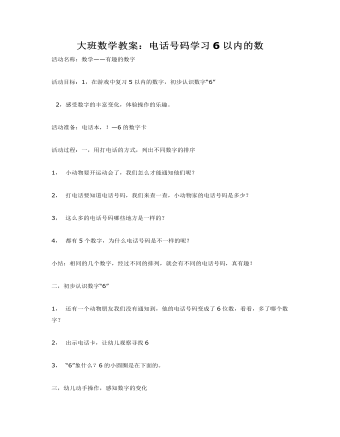
大班数学教案:电话号码学习6以内的数
活动准备:电话本,!—6的数字卡活动过程:一,用打电话的方式,列出不同数字的排序1, 小动物要开运动会了,我们怎么才能通知他们呢?2, 打电话要知道电话号码,我们来查一查,小动物家的电话号码是多少?3, 这么多的电话号码哪些地方是一样的?4, 都有5个数字,为什么电话号码是不一样的呢?小结:相同的几个数字,经过不同的排列,就会有不同的电话号码,真有趣!
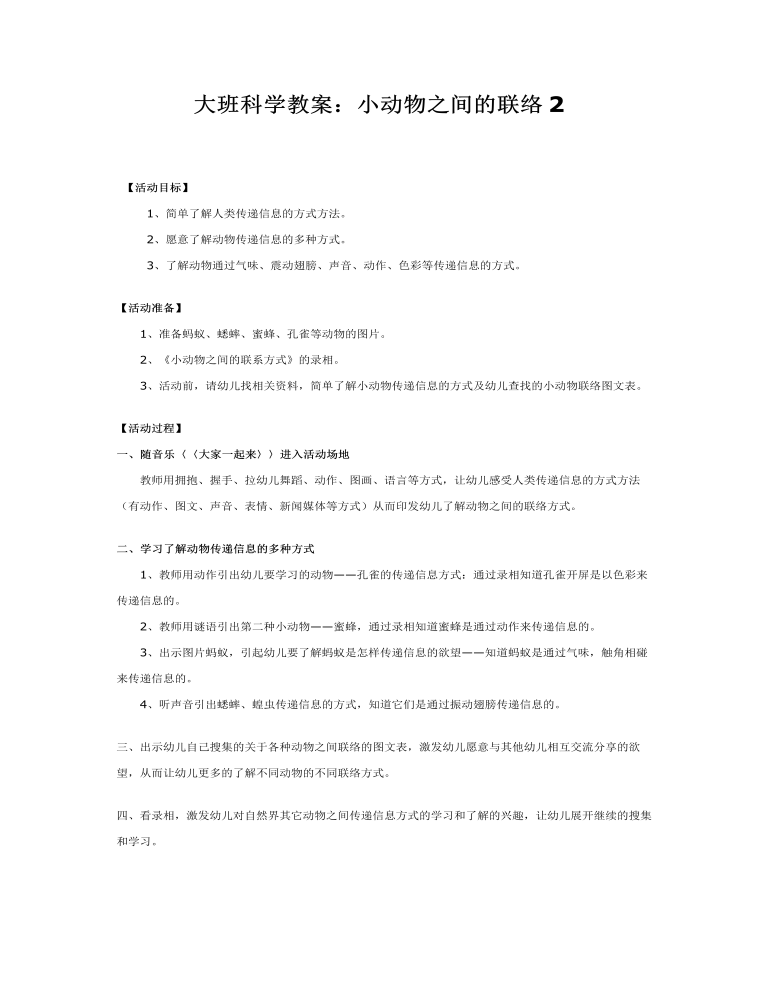
大班科学教案:小动物之间的联络2
【活动准备】1、准备蚂蚁、蟋蟀、蜜蜂、孔雀等动物的图片。2、《小动物之间的联系方式》的录相。3、活动前,请幼儿找相关资料,简单了解小动物传递信息的方式及幼儿查找的小动物联络图文表。【活动过程】一、随音乐〈〈大家一起来〉〉进入活动场地 教师用拥抱、握手、拉幼儿舞蹈、动作、图画、语言等方式,让幼儿感受人类传递信息的方式方法(有动作、图文、声音、表情、新闻媒体等方式)从而印发幼儿了解动物之间的联络方式。
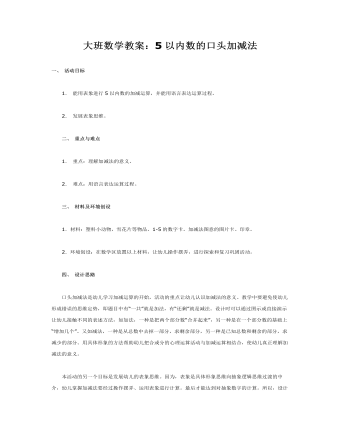
大班数学教案:5以内数的口头加减法
2.发展表象思维。 二、重点与难点1.重点:理解加减法的意义。 2.难点:用语言表达运算过程。 三、材料及环境创设 1.材料:塑料小动物,雪花片等物品。1-5的数字卡。加减法图意的图片卡。印章。 2.环境创设:在数学区放置以上材料,让幼儿操作摆弄,进行探索和复习巩固活动。
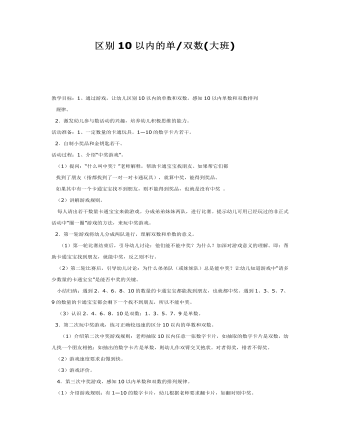
大班数学教案:区别10以内的单双数
2.激发幼儿参与数活动的兴趣,培养幼儿积极思维的能力。 活动准备:1、一定数量的卡通玩具。1—10的数字卡片若干。 2.自制小奖品和金钥匙若干。 活动过程:1、介绍“中奖游戏”。 (1)提问:“什么叫中奖?”老师解释,帮助卡通宝宝找朋友。如果帮它们都 找到了朋友(指都找到了一对一对卡通玩具),就算中奖,能得到奖品。 如果其中有一个卡通宝宝找不到朋友,则不能得到奖品,也就是没有中奖。 (2)讲解游戏规则。 每人请出若干数量卡通宝宝来做游戏。分成弟弟妹妹两队,进行比赛。提示幼儿可用已经玩过的非正式活动中“圈一圈”游戏的方法,来玩中奖游戏。 2.第一轮游戏将幼儿分成两队进行,理解双数和单数的意义。 (1)第一轮比赛结束后,引导幼儿讨论:他们能不能中奖?为什么?加深对游戏意义的理解。即:帮助卡通宝宝找到朋友,就能中奖,反之则不行。 (2)第二轮比赛后,引导幼儿讨论:为什么弟弟队(或妹妹队)总是能中奖?让幼儿知道游戏中“请多少数量的卡通宝宝”是能否中奖的关键。 小结归纳:遇到2、4、6、8、10的数量的卡通宝宝都能找到朋友,也就都中奖。遇到1、3、5、7、9的数量的卡通宝宝都会剩下一个找不到朋友,所以不能中奖。 (3)认识2、4、6、8、10是双数;1、3、5、7、9是单数。
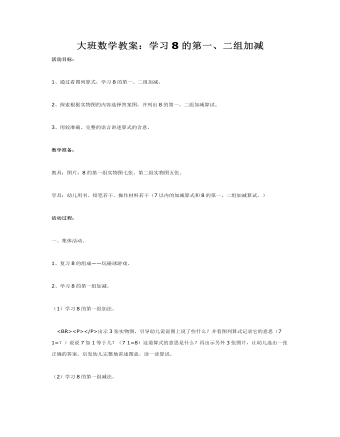
大班数学教案:学习8的第一、二组加减(江苏)
2、探索根据实物图的内容选择答案图,并列出8的第一、二组加减算试。3、用较准确、完整的语言讲述算式的含意。教学准备:教具:图片:8的第一组实物图七张、第二组实物图五张。学具:幼儿用书、铅笔若干。操作材料若干(7以内的加减算式和8的第一、二组加减算试。)活动过程:一、集体活动。1、复习8的组成——玩碰球游戏。2、学习8的第一组加减。
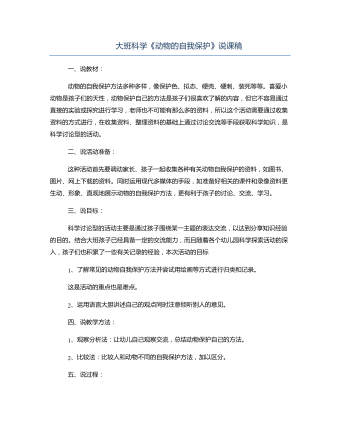
大班科学《动物的自我保护》说课稿
动物的自我保护方法多种多样,像保护色、拟态、硬壳、硬刺、装死等等。喜爱小动物是孩子们的天性,动物保护自己的方法是孩子们很喜欢了解的内容,但它不容易通过直接的实验或探究进行学习,老师也不可能有那么多的资料,所以这个活动需要通过收集资料的方式进行,在收集资料、整理资料的基础上通过讨论交流等手段获取科学知识,是科学讨论型的活动。这种活动首先要调动家长、孩子一起收集各种有关动物自我保护的资料,如图书、图片、网上下载的资料。同时运用现代多媒体的手段,如准备好相关的课件和录像资料更生动、形象、直观地展示动物的自我保护方法,更有利于孩子的讨论、交流、学习。

大班科学《物体怎样移动》说课稿
“物体的移动”除了教幼儿获取有关的物体移动需要的具体经验外,还要对幼儿进行相关的科学知识教学,并从科学探索出发,生成有关技术的目标和内容,将幼儿的科学与技术学习有机地、自然地结合起来。在教幼儿“物体怎样移动”的之前,我预设了一下“物体怎样移动”的学前目标:首先,引导幼儿在玩的过程中,自己尝试让物体动起来,使幼儿感受物体运动和力的关系,获取有关物体移动需要力的具体经验。其次,让幼儿尝试用力大和用力小的时候,物体移动的一样吗?再次,让幼儿想办法在不用身体碰物体的情况下,还有什么办法让物体动起来?最后,要培养幼儿的观察力,并激发幼儿探索自然现象的兴趣。在学习 “物体怎样移动”的时候,教师为幼儿共同准备了各种物体。如:积木、汽车、纸、圆珠笔、各类玩具以及绳子、轮子、木板等等。为了让幼儿更好的投入到活动中去,在进入教室之前,我领着幼儿在室外活动了一下。随后我放开音乐,幼儿听着音乐《碰碰车》来到了教室,看到地上放着各类玩具,顿时来了兴趣。我趁机说:“小朋友们,地上放了这么多的玩具,我好想玩一玩,你们想玩吗?”说完,我就独自拿着玩具玩起来,小朋友也跟着玩起来。在我的启发和引导下,孩子们开始了活动中的第一次尝试,在这一环节中,教师给了幼儿自由探索的空间和材料,让幼儿通过尝试,发现物体自己是不动的,只有去推它碰它物体才会移动。
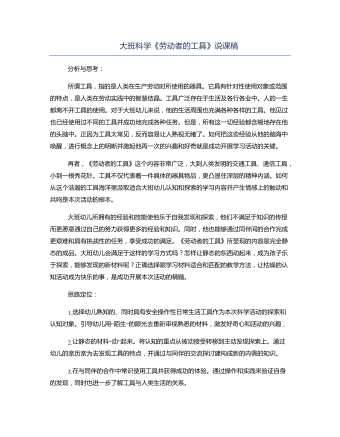
大班科学《劳动者的工具》说课稿
大班幼儿所拥有的经验和技能使他乐于自我发现和探索,他们不满足于知识的传授而更愿意通过自己的努力获得更多的经验和知识。同时,他也能够通过同伴间的合作完成更艰难和具有挑战性的任务,享受成功的满足。《劳动者的工具》所显现的内容是完全静态的成品。大班幼儿会满足于这样的学习方式吗?怎样让静态的东西动起来,成为孩子乐于探索,能够发现的新材料呢?正确选择跟学习材料适合和匹配的教学方法,让枯燥的认知活动成为快乐的事,是成功开展本次活动的精髓。思路定位:1.选择幼儿熟知的、同时具有安全操作性日常生活工具作为本次科学活动的探索和认知对象。引导幼儿用“陌生”的眼光去重新审视熟悉的材料,激发好奇心和活动的兴趣,2.让静态的材料“动”起来。将认知的重点从被动接受转移到主动发现探索上。通过幼儿的亲历亲为去发现工具的特点,并通过与同伴的交流探讨建构成新的内需的知识。3.在与同伴的合作中常识使用工具并获得成功的体验。通过操作和实践来验证自身的发现,同时也进一步了解工具与人类生活的关系。具体教案与环节分析:[活动目标]1.运用多种感官探索和发现工具的秘密,积极探讨交流自己的发现和见解。2.尝试和同伴合作使用某一工具完成任务,体验合作的快乐和尝试的成功。3.初步了解工具与人类生活的关系,激发自豪感。
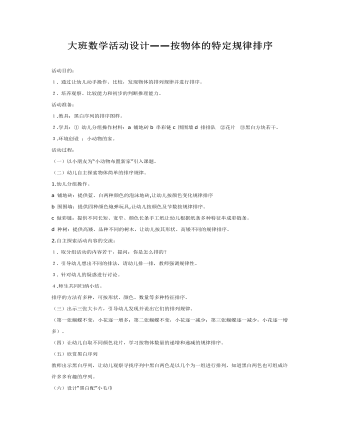
大班数学教案:按物体的特定规律排序
2. 培养观察、比较能力和初步的判断推理能力。活动准备: 1.教具:黑白序列的排序图样。2.学具:①幼儿分组操作材料:a 铺地砖b 串彩链c 围围墙d 排排队 ②花片 ③黑白方块若干。3.环境创设:小动物的家。活动过程:(一)以小朋友为“小动物布置新家”引入课题。(二)幼儿自主探索物体简单的排序规律。1.幼儿分组操作。a 铺地砖:提供蓝、白两种颜色的泡沫地砖,让幼儿按颜色变化规律排序 b 围围墙:提供四种颜色炮弹玩具,让幼儿按颜色及节数按规律排序。c 做彩链:提供不同长短、宽窄、颜色长条手工纸让幼儿根据纸条多种特征串成彩链条。d 种树:提供高矮、品种不同的树木,让幼儿按其形状、高矮不同的规律排序。

大班数学教案:仿编5以内的加法应用题
活动准备: 1、5以内加法算式卡片若干张,加法图片若干张,口述图片5张。 2、红、黄、绿队牌三张、抢答器(锣)三个,数字贴纸(选手号)若干张、统计牌一个,奖牌榜三张、 3、红苹果若干个、奖状若干张、颁奖音乐一首。 活动过程: 一、引题 1、师:大家好,欢迎你们来到快乐数学大本营,我是快乐数学栏目主持人——小问号。我们快乐数学大本营的口号是:快乐数学,快乐无限!我们现在整齐、响亮地把口号喊出来:快乐数学,快乐无限!ye! 首先我来介绍今天参加我们快乐数学大本营的三个方队,他们是(举队牌)——红队,欢迎你们!他们是——黄队,欢迎你们!他们是——绿队,欢迎你们!接下来我们马上进入快乐数学第一关。 二、快乐数学第一关。 1、师:第一关:必答题。红黄绿队的每一位选手都要回答一道题目,每答对一题,奖励一个红苹果。看哪一队的红苹果个数最多。 2、师:答题开始。请听题3+3=?(教师请三位选手轮流回答,提醒幼儿把题读完整),例幼儿:2+3=5 师:(出示正确答案)回答正确。(三位选手依此回答完毕)。
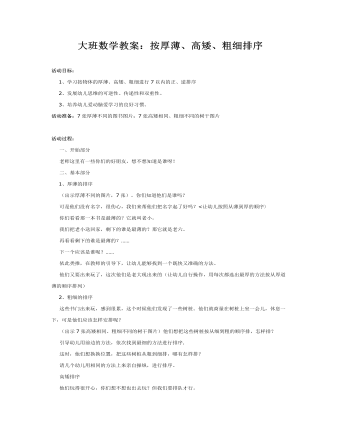
大班数学教案:按厚薄、高矮、粗细排序
2、发展幼儿思维的可逆性、传递性和双重性。 3、培养幼儿爱动脑爱学习的良好习惯。活动准备:7张厚薄不同的图书图片;7张高矮相同、粗细不同的树干图片 活动过程: 一、开始部分 老师这里有一些你们的好朋友,想不想知道是谁呀! 二、基本部分 1、厚薄的排序 (出示厚薄不同的图片,7张)。你们知道他们是谁吗? 可是他们没有名字,很伤心,我们来帮他们把名字起了好吗?<让幼儿按照从薄到厚的顺序〉

